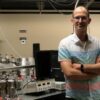The CMS collaboration at the Large Hadron Collider (LHC) has carried out a new test on a model that was developed to explain the tiny mass of neutrinos, electrically neutral particles that change type as they travel through space.
In the Standard Model of particle physics, the particles that cannot be broken down into smaller constituents, such as quarks and electrons, gain their mass through their interactions with a fundamental field associated with the Higgs boson. The neutrinos are the exception here, however, as this Higgs mechanism cannot explain their mass. Physicists are therefore investigating alternative explanations for the mass of neutrinos.
One popular theoretical explanation is a mechanism that pairs up a known light neutrino with a hypothetical heavy neutrino. In this model, the heavier neutrino plays the part of a larger child on a seesaw, lifting the lighter neutrino to give it a small mass. But, for this seesaw model to work, the neutrinos would need to be Majorana particles, that is, their own antimatter particles.
In its recent study, the CMS team tested the seesaw model by searching for Majorana neutrinos produced through a specific process, called vector-boson fusion, in data from high-energy collisions at the LHC collected by the CMS detector between 2016 and 2018. If they took place, these collision events would result in two muons (heavier versions of the electron) that had the same electric charge, two “jets” of particles that had a large total mass and were wide apart from one another, and no neutrino.
After identifying and subtracting a background of collision events that look almost the same as the sought-after events, the CMS researchers found no signs of Majorana neutrinos in the data. However, they were able to set new bounds on a parameter of the seesaw model that describes the quantum mixing between a known light neutrino and a hypothetical heavy neutrino.
The results include bounds that surpass those obtained in previous LHC searches for a heavy Majorana neutrino with a mass larger than 650 billion electronvolts (GeV), and the first direct limits for a heavy Majorana neutrino that has a mass larger than 2 trillion electronvolts (TeV) and up to 25 TeV.
With the LHC set to be back in collision mode this summer, after a successful restart on 22 April, the CMS team can look forward to collecting more data and trying out the seesaw again.
More information:
Probing Majorana neutrinos and the Weinberg operator in the same-charge dimuon channel through vector boson fusion processes in proton-proton collisions at s√=s= 13 TeV. cms-results.web.cern.ch/cms-re … XO-21-003/index.html
Citation:
Researchers test key neutrino model at the Large Hadron Collider (2022, May 4)



